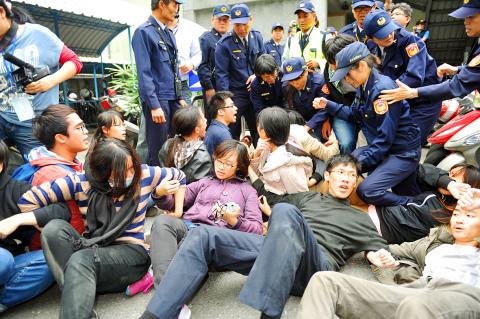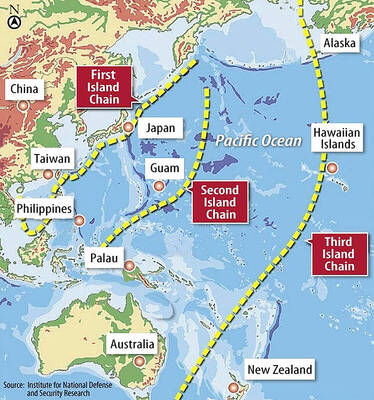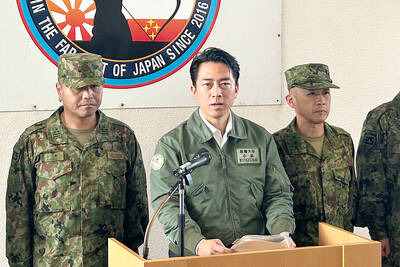The controversial construction of Miramar Resort Village at Taitung County’s Shanyuan Bay (杉原灣) gained conditional approval from a seventh Environmental Impact Assessment (EIA) meeting yesterday, despite heated debate over the legitimacy of the project and the EIA meeting.
The joint build-operate-transfer project by the developer and the county government began construction in 2004.
The main building was built on a less than 1 hectare area by the beach, to avoid the EIA required for construction projects on land of more than 1 hectares.

Photo: Huang Chih-yuan, Taipei Times
The project later gained conditional approval from an EIA meeting at the local government for a total area of 6 hectares in 2008.
The project has sparked protests and lawsuits by environmentalists and local residents, and the Supreme Administrative Court in January made a final verdict ruling the project’s EIA conclusion invalid.
It reached another final verdict in September ordering the project to stop construction.

Photo: Huang Chih-yuan, Taipei Times
However, the Taitung County Government and the developer insisted the project was still legal and that it only needed to redo the EIA process and gain approval to proceed with its construction and operation plans.
Yesterday’s EIA meeting was held at the Taitung County Government, with hundreds of proponents and opponents of the project gathered outside the meeting venue.
Holding banners and calling on the protesters not to interfere with the meeting, local supporters and the Taitung Tourism Association shouted that the hotel would bring job opportunities.
Also holding up banners, people against the project questioned the legitimacy of redoing an EIA, saying it should be based on “precautionary principles” when the damage from the construction had already been done and that the EIA committee members were mostly from environmental engineering backgrounds, lacking expertise in the marine ecology, social and cultural aspects of the issue.
Meanwhile, more than 100 police were deployed outside the venue to prevent clashes between the different groups.
Police dragged several protesters along the ground or held them back with force to prevent them from entering the meeting.
The meeting convener — Taitung County Environmental Protection Bureau director Huang Ming-en (黃明恩) — led the committee members to another room for final discussions and refused to allow the media to enter the venue.
Following a closed-door meeting that lasted about half an hour, Huang announced that the project had been conditionally approved. Details of the conditions were not explained.
Shouting: “Illegal EIA meeting with invalid conclusion,” protesters said the EIA meeting yesterday was illegal and flawed and that as such, the meeting’s conclusion may be ruled invalid in court in the future.

LIMITS: While China increases military pressure on Taiwan and expands its use of cognitive warfare, it is unwilling to target tech supply chains, the report said US and Taiwan military officials have warned that the Chinese People’s Liberation Army (PLA) could implement a blockade within “a matter of hours” and need only “minimal conversion time” prior to an attack on Taiwan, a report released on Tuesday by the US Senate’s China Economic and Security Review Commission said. “While there is no indication that China is planning an imminent attack, the United States and its allies and partners can no longer assume that a Taiwan contingency is a distant possibility for which they would have ample time to prepare,” it said. The commission made the comments in its annual

DETERMINATION: Beijing’s actions toward Tokyo have drawn international attention, but would likely bolster regional coordination and defense networks, the report said Japanese Prime Minister Sanae Takaichi’s administration is likely to prioritize security reforms and deterrence in the face of recent “hybrid” threats from China, the National Security Bureau (NSB) said. The bureau made the assessment in a written report to the Legislative Yuan ahead of an oral report and questions-and-answers session at the legislature’s Foreign Affairs and National Defense Committee tomorrow. The key points of Japan’s security reforms would be to reinforce security cooperation with the US, including enhancing defense deployment in the first island chain, pushing forward the integrated command and operations of the Japan Self-Defense Forces and US Forces Japan, as

IN THE NATIONAL INTEREST: Deputy Minister of Foreign Affairs Francois Wu said the strengthening of military facilities would help to maintain security in the Taiwan Strait Japanese Minister of Defense Shinjiro Koizumi, visiting a military base close to Taiwan, said plans to deploy missiles to the post would move forward as tensions smolder between Tokyo and Beijing. “The deployment can help lower the chance of an armed attack on our country,” Koizumi told reporters on Sunday as he wrapped up his first trip to the base on the southern Japanese island of Yonaguni. “The view that it will heighten regional tensions is not accurate.” Former Japanese minister of defense Gen Nakatani in January said that Tokyo wanted to base Type 03 Chu-SAM missiles on Yonaguni, but little progress

NO CHANGES: A Japanese spokesperson said that Tokyo remains consistent and open for dialogue, while Beijing has canceled diplomatic engagements A Japanese official blasted China’s claims that Japanese Prime Minister Sanae Takaichi has altered Japan’s position on a Taiwan crisis as “entirely baseless,” calling for more dialogue to stop ties between Asia’s top economies from spiraling. China vowed to take resolute self-defense against Japan if it “dared to intervene militarily in the Taiwan Strait” in a letter delivered Friday to the UN. “I’m aware of this letter,” said Maki Kobayashi, a senior Japanese government spokeswoman. “The claim our country has altered its position is entirely baseless,” she said on the sidelines of the G20 summit in Johannesburg on Saturday. The Chinese Ministry